Ready to transform your kitchen and go zero-waste? Here are 7 changes that I’ve made in my own kitchen that helped me eliminate the majority of the waste.
I wrote about how to reduce the food waste in an earlier blog post, so in today’s post we will take it a step further and make our whole kitchen “waste-free”.
Step 1: Replace paper towels with cloth towels
This happened to be the first change that I made going zero-waste in the kitchen. I read an article “Save Money in the Kitchen with Cloth” from Wellness Mama. She explained that she was using hack towels instead of regular paper rolls. This got me curious since I’ve never heard of “huck towels” before.
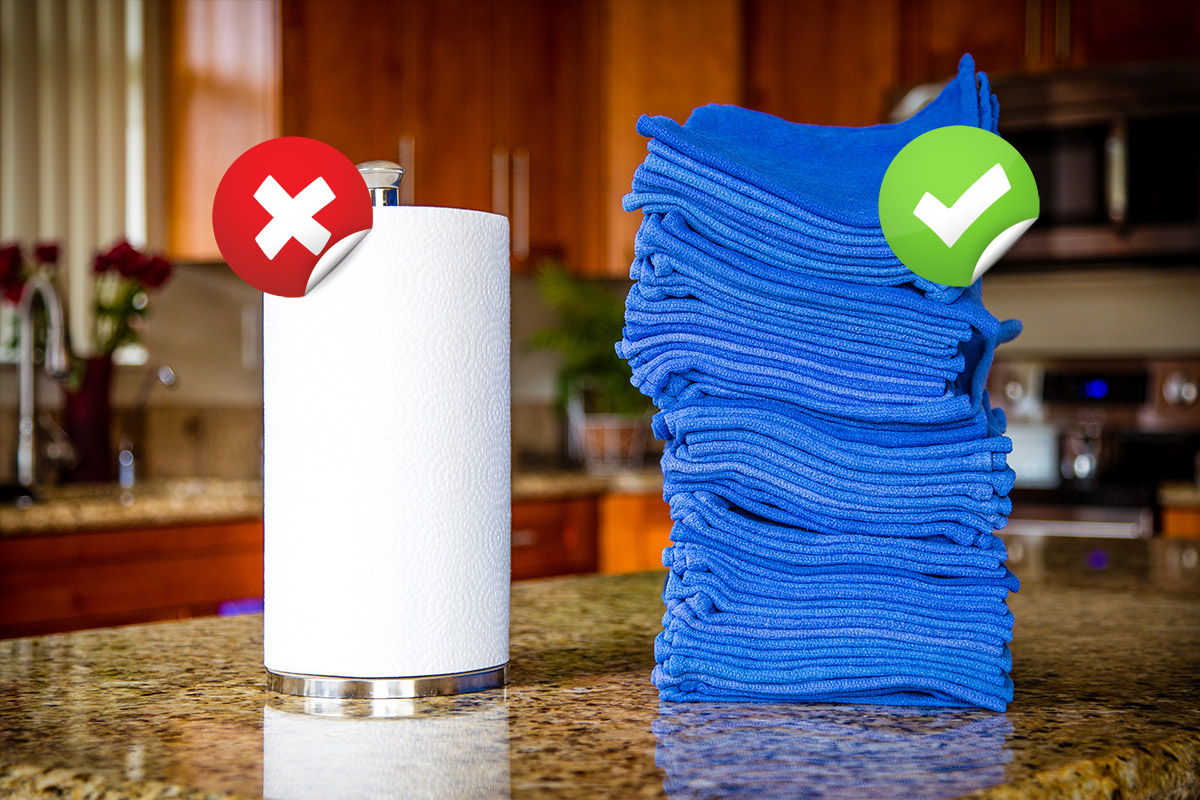
As it turns out, hospitals use huck towels for cleaning surgical instruments. These towels are durable, super absorbent and lint free. They are usually dark blue in color. This camouflages the stains better than if they were white or any other lighter color.
When I found out that Tim Ferris was recommending these towels in his book “The 4-Hour Chef”, I was convinced.
In the beginning, I didn’t know how many towels I would need to keep a steady supply for our household. I didn’t want to risk to run out of towels. So I went to Amazon and bought 100 towels.
Having a big stash of towels keeps the pressure away from having to wash them often, or risking running out of them.
It also helped me to convince the rest of my family to switch. I told them that they could use the cloth towels in the exact same way as they would use a paper version. They could use it once and throw it in the wash. This made the transition easier.
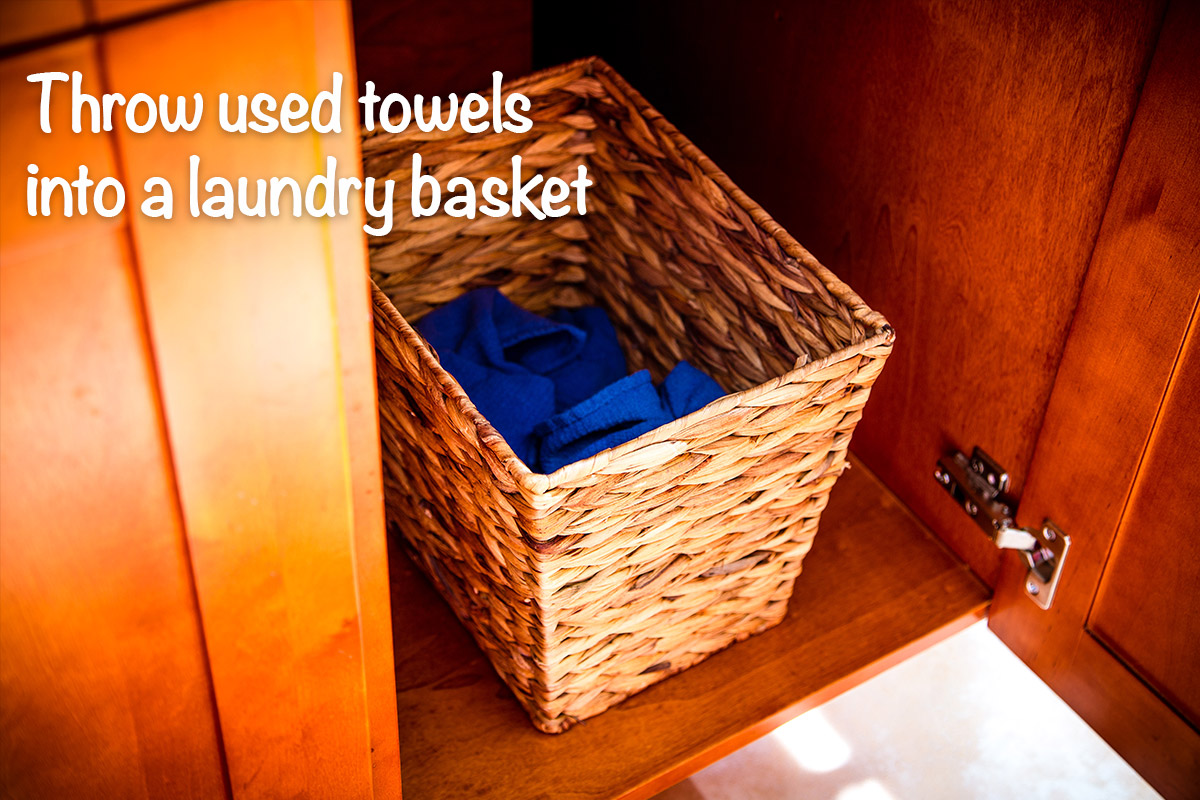
After a while, everyone became more comfortable reusing them: it’s not as scary anymore. If we dry our hands or clean dishes with a towel, we don’t throw it in the wash right away. Instead, we hang them to dry in the kitchen and reuse them.
Now, you may not need to buy that many towels. On a typical day, we use about 2-3 towels. That means 15-20 towels per week. If you wash them weekly, this may be enough for you.
To make the transition easier, use the towels for “clean” tasks like drying your hands and dishes. Continue using the paper towels for other, more dirty tasks. In this case, you can start with as few as 10 towels.
These towels from Amazon are the best that I could find.
How I take care of the cloth towels
I wash them on a regular warm cycle in the washing machine. As you probably know already, fabric softener will make the towels less absorbent, so leave that out.
At first, I was tumble drying the towels. But, that created a lot of lint in the dryer, and I figured that at that rate my towels will get old fast. Also, when they came out of the dryer, they were so wrinkled that I had to iron them to get them to a decent, usable shape. That was time-consuming.
Today, I line dry them on a compact line drying rack. This is perfect because:
- I fold them wet and hang to dry: no wrinkles!
- I don’t destroy the towels in the dryer so they will last longer
- I save energy by not using the dryer
- I save energy and time by not having to iron them
- I save time because when I remove the dry towels from the line, they are already folded!
The process of switching to cloth towels wasn’t as smooth as I imagined. I had to create a new process for taking care of the towels.
But it was all worth the effort in the end. Today, we use the cloth towels for most of the jobs in the kitchen, leaving the paper towels only for the toughest messes.
We used to consume one large roll of paper towels every week. Now that roll lasts 2-3 months.
Step 2: Replace paper napkins with cloth napkins
Although huck towels make perfect dinner napkins, I wanted something closer to a traditional dinner napkin. Also, we needed a solution for handkerchiefs as well.
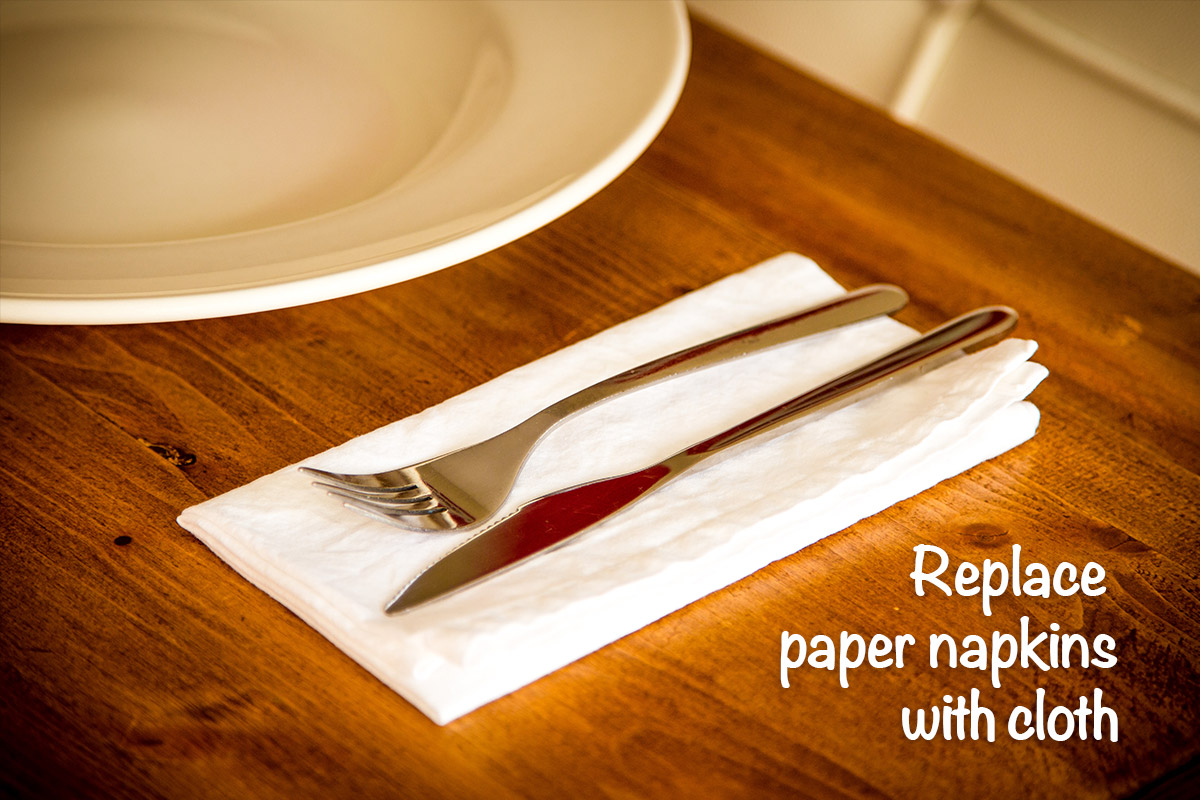
So I decided to sew white napkins from an old bed sheet. This way I was reusing the bed sheet instead of throwing it away, thus reducing our household waste. Also, if I had to buy a new set of cloth napkins, I would have paid about $20. By making the napkins myself, I saved money, which is always a good thing.
If you want to make the napkins yourself, here is a great YouTube tutorial that reveals a little secret to how to fold the corners of the napkins when sewing.
If sewing is not your thing, you can get a nice set of white dinner napkins at Amazon.
Step 3: Invest in reusable grocery bags
Here is a statistic from the Earth Policy Institute:
Worldwide, a trillion single-use plastic bags are used each year, nearly 2 million each minute.
An average American family takes home about 1,500 plastic bags each year, according to the The Natural Resources Defense Council.
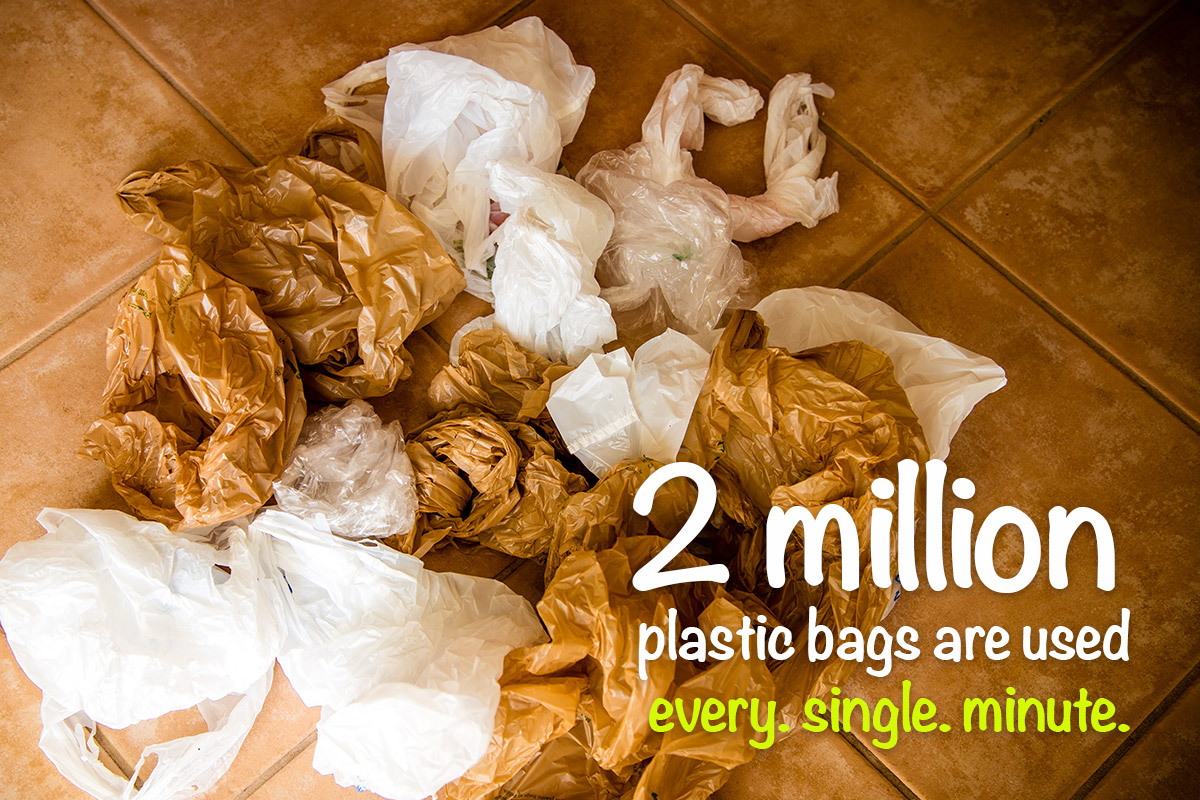
When I see these numbers, I realize that I don’t want to be part of it. Although most shopping trips end up with a plastic bag, grocery shopping is going to be the winner for most of us.
If you want to reduce the amount of plastic bags that you bring home, start with your groceries.
As with the dinner napkins, I decided to sew my own (pictured below). The natural fabric is from IKEA, and the green patterned fabric is an old baby blanket (also from IKEA). I followed The Market Tote tutorial to make them.
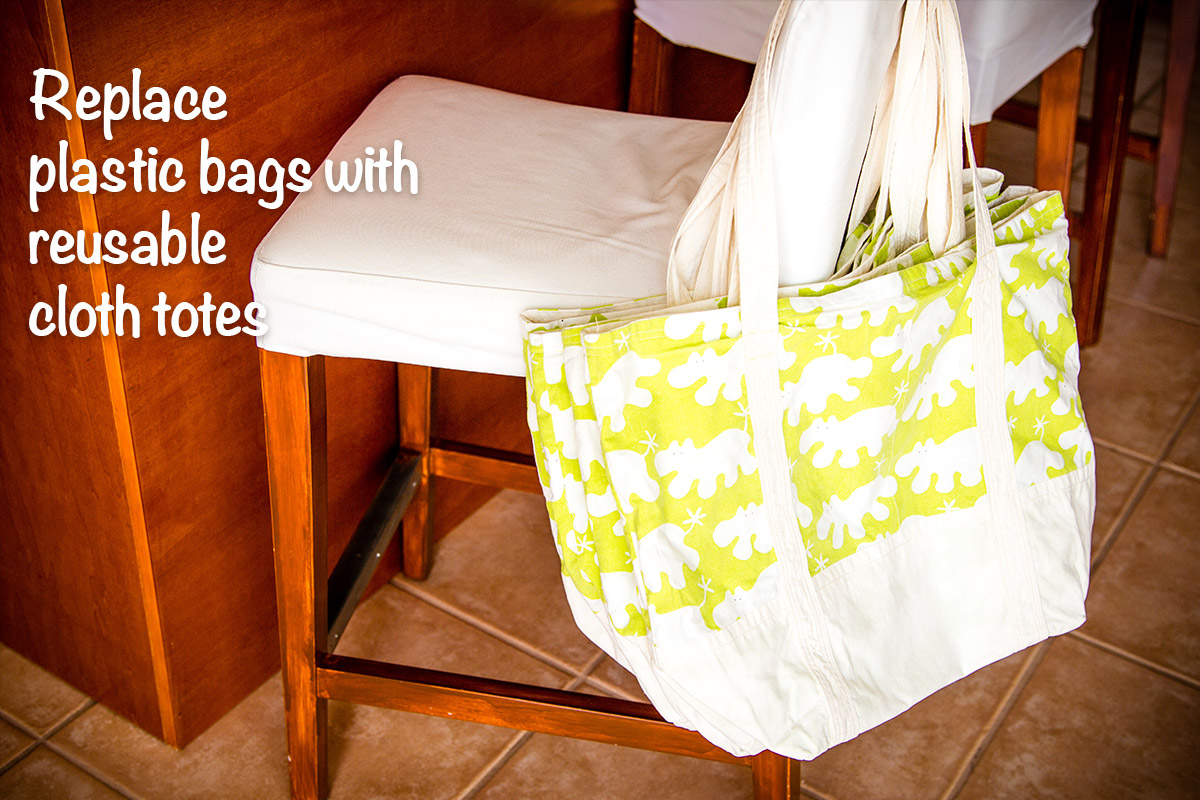
If you want to buy the bags instead, check out these organic cotton totes from Amazon, they come in 3-pack.
As it turned out, getting the reusable bags was not the hardest part of the switch. Remembering to take them with you when you head out the door is much harder. We are just not used to think about it.
One strategy is to keep the bags in the car, period. When you have brought your groceries home and unpacked them, put the bags into the car immediately. Another option is to keep some kind of a reminder on the front door.
Step 4: Use cloth bags for produce
What about the smaller plastic bags, the ones we use for the fruits and vegetables? You need to find a sustainable alternative to those, too.
Again, I went with a homemade option and made the produce bags myself. Wellness Mama has a detailed tutorial on how to make them.
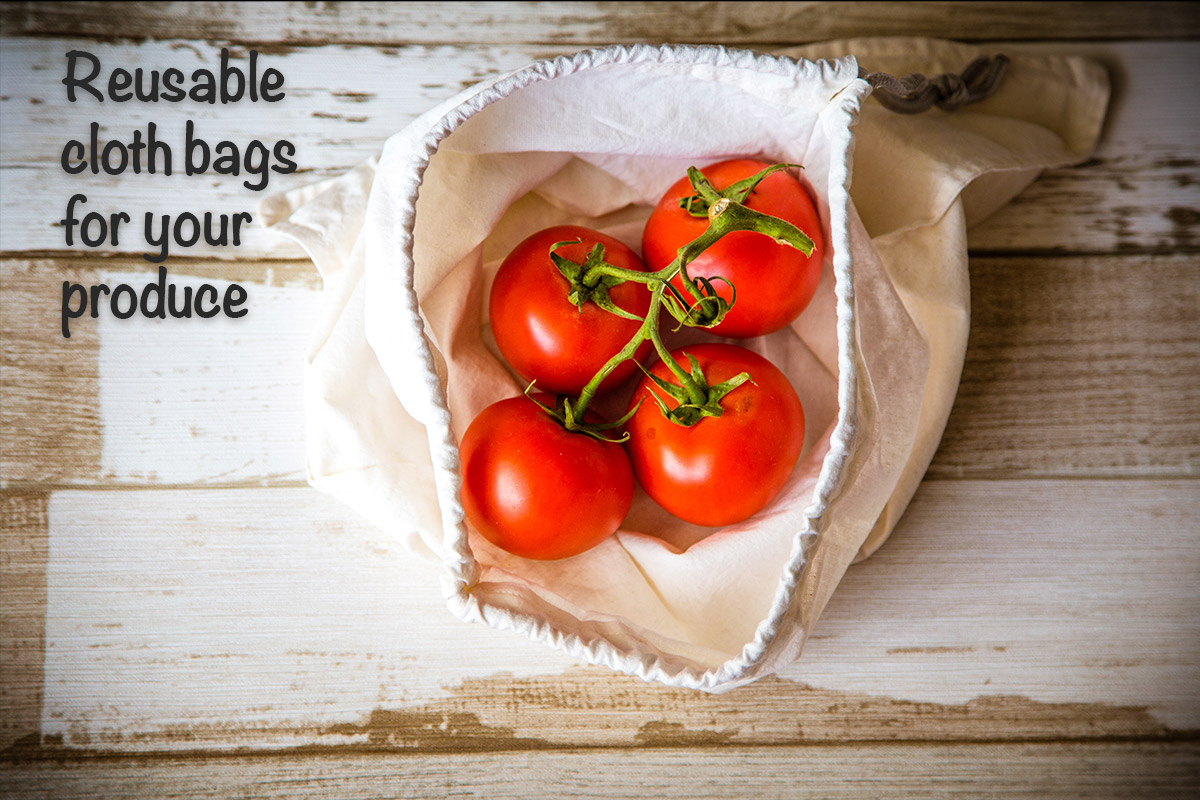
And again, you don’t have to do it if sewing is not your thing. Amazon has some great options, but before you go and spend your money, see if you have anything in your house that could work.
For example, Bea Johnson, the pioneer of the zero waste movement, is using old pillow cases for breads.
Step 5: Store food in glass containers
How do you store your food? Perhaps, you wrap your cheese in a plastic wrapper. Or maybe store leftovers in a plastic zip-lock bag. Now that we’ve covered grocery shopping, lets look at what we can do with food storage.
You need to replace the plastic containers, bags and wrappers with glass containers.
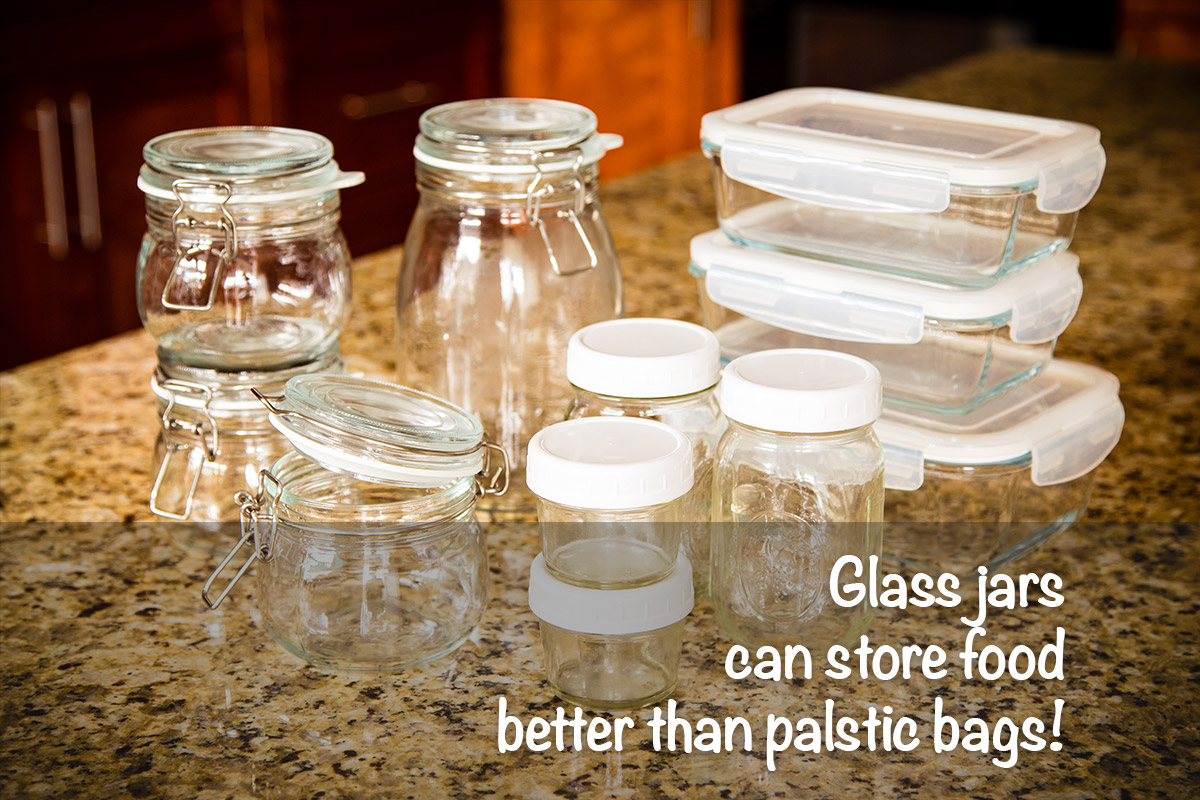
Invest in a collection of glass jars and containers, in different sizes, that solve all your food storage needs. Start with a few basic items, and expand your collection if needed.
I got most of my glass containers from IKEA. You may notice that some of the glass containers come with a plastic lid.
Not so long ago I discovered an online store that only sells plastic-free items, and it’s conveniently named “Life Without Plastic”. They have a great selection of glass and metal storage containers, so check it out.
What about containers that don’t have a lid? It can be a bowl or a plate with leftovers. Do you need to resolve to disposable plastic wrap to keep your food fresh?
Of course not! Instead of buying plastic wrap, invest in food storage flats or stretchable silicone lids.
Step 6: Buy bulk and big packs of staple items
There is one thing that you don’t have direct control over: it’s how the foods that you buy are packaged. And the food manufactures are happy to pack the foods in layers after layers of plastic. The worst offenders are the individually wrapped foods: so much waste for so little food!
What can you do? You have taken so much effort to eliminate the waste, and then you bring home a pack of ready-made burritos and end up with a huge pile of plastic packaging!
One solution is, of course, to refuse buying anything in packaging. You can buy your greens at the farmers market, your meats at the local butcher’s, your milk at the…
When I read the zero waste blogs, they often paint this wonderful picture of a life free from supermarkets, where you get everything local from the farmers.
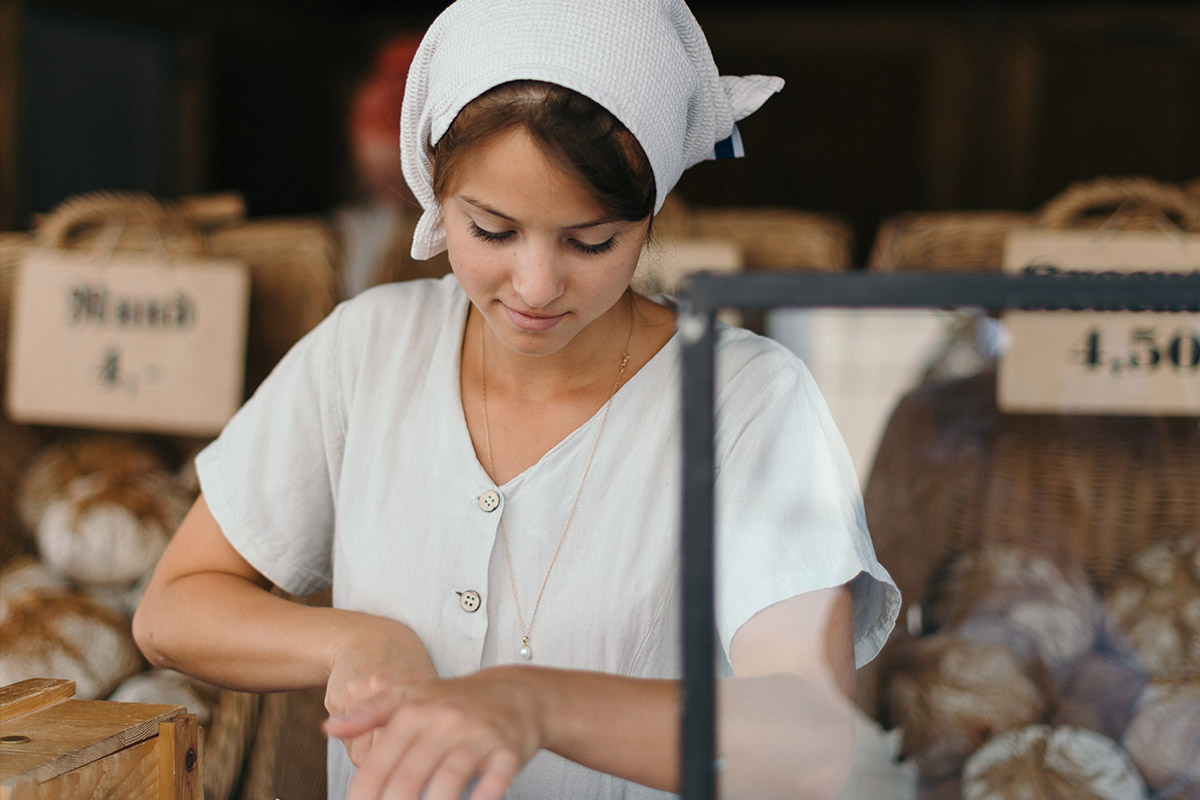
The reality is: it’s hard. It’s hard to find those suppliers, and sometimes you may not have any near you, no matter how hard you try.
This looks like going back in time, to the pre-supermarket era. To the time where you had to go to several places to get all your food supplies.
Let’s admit: it’s not very practical. Also, if you have to drive to several places just to cover a week’s supply of groceries, you will increase your carbon footprint from driving. And it’s time-consuming, of course.
The long-term solution is to press the supermarkets to adapt to a zero-waste approach. But it won’t happen overnight. What should we do in the mean time?
Buy bulk
Bulk is a better option than buying packaged foods. Yes, the food still arrives in packaging to the supermarket. They remove it from the package and fill those bulk containers. But, one large bag of, say, walnuts will use less packaging than many small bags of walnuts that are packaged for the shelf.
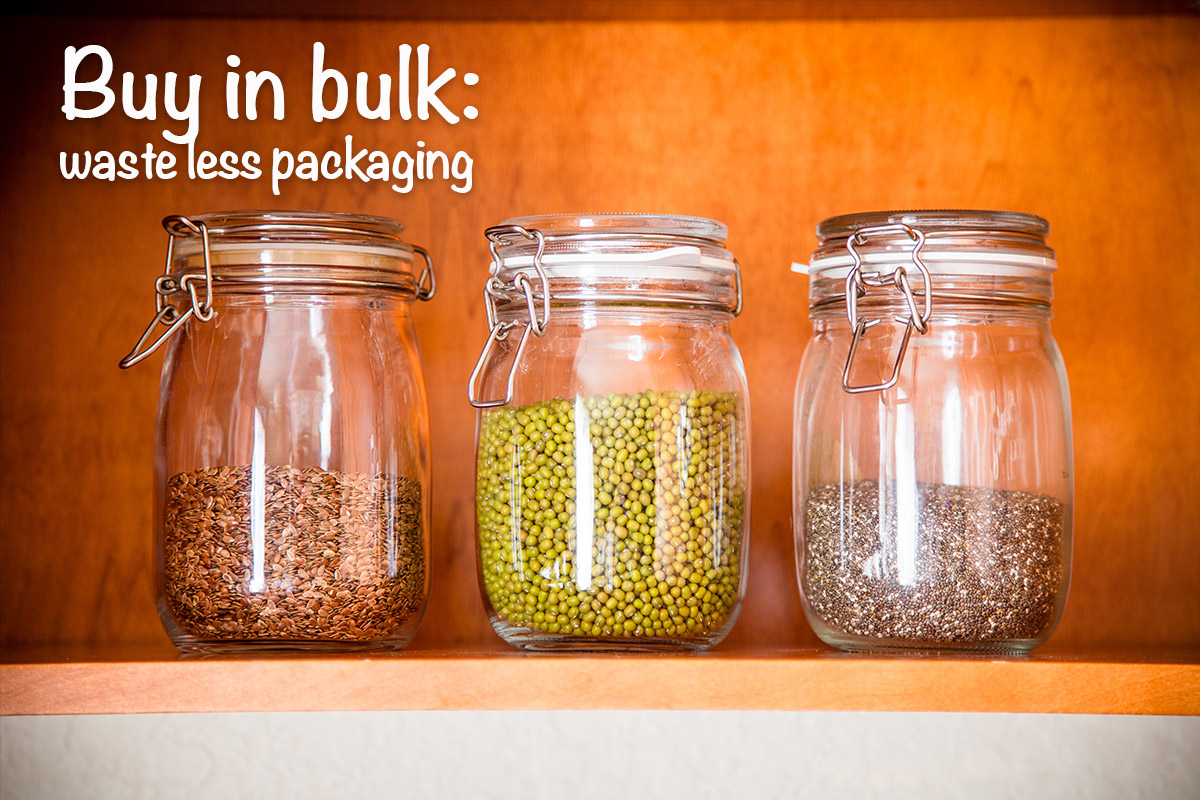
Buy big packs of staple items
A 10 pound bag of salt will use less packaging than buying 20 small bags of half a pound packs of salt. Next time you need to refill your supply of rice, beans, salt, etc., go for a big pack option. You will save on both packaging and money.
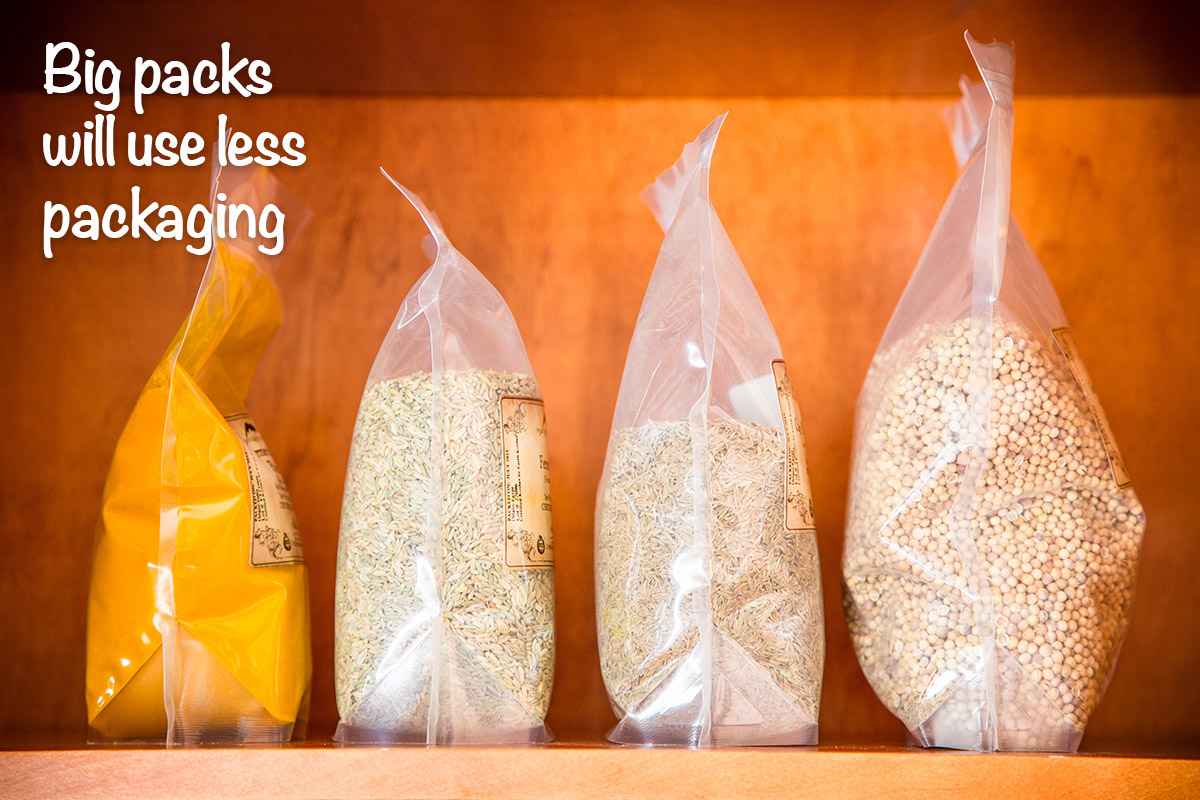
But, use caution: this only works if you use up the bulk food before it expires. Needless to say that if you end up throwing the bulk food away, you wasted your money and created unnecessary garbage.
Step 7: Shop for packaging!
When you buy food, you most probably focus on the food itself. The package is just something that helps store and transport the food.
At most, you will worry about how you will dispose of the package. If you’re reading this, you’re probably going to pay closer attention to the packaging, but again, only from the environmental impact point of view.
But what if you can do more? What if you can have real use from both the food and the package? Wouldn’t it be much better? No matter how environmentally friendly a packaging is, it will still make a negative impact on the environment.
Recycling is not a zero-waste process: although it can reuse some of the packaging materials, there is still going to be waste generated. Also, recycling consumes energy, and energy is an expensive commodity, that contributes to global pollution.
So next time you go to the supermarket, shop for packaging that you can save and use.
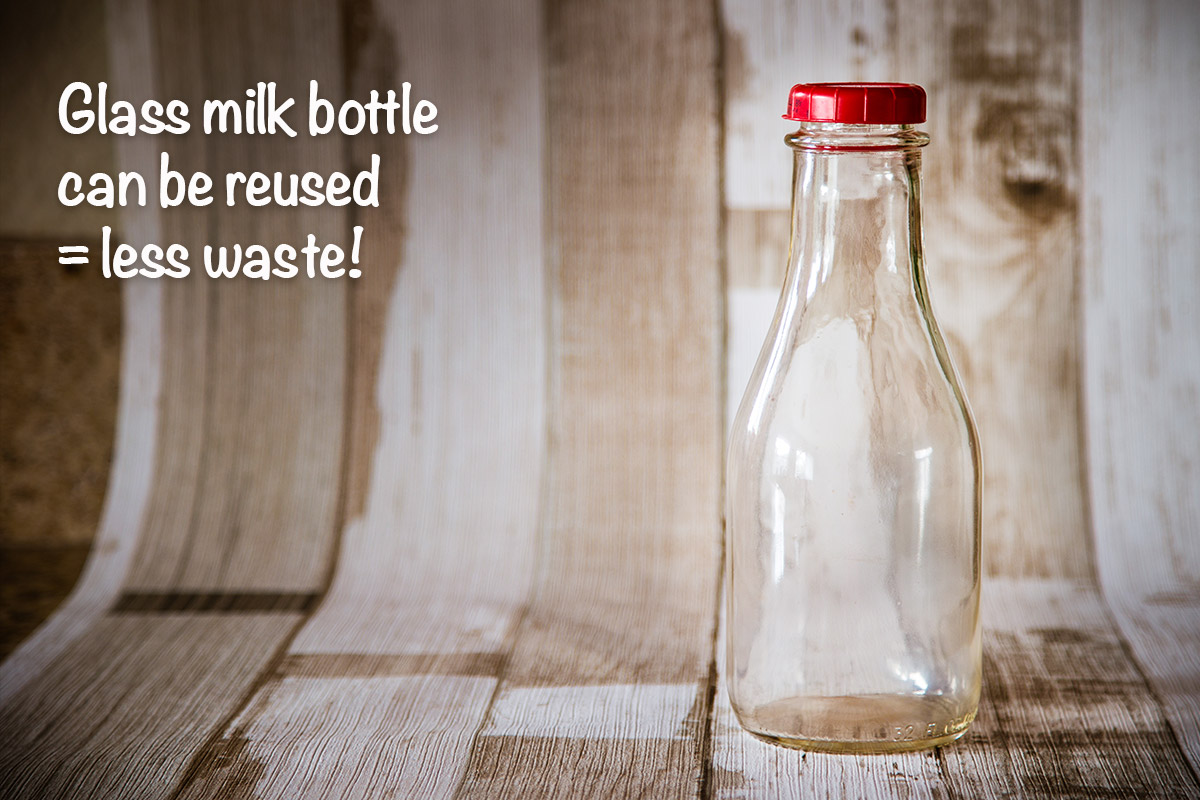
Here are some ideas for packaging that you can reuse:
- Glass bottles: buy milk, olive oil, etc. in a glass bottle and use the bottle to store water and drinks
- Glass jars: the most universal solution. You can use them to store foods, obviously, but it doesn’t end there. These jars can be used to store pens, nails, and any other small items.
- Tin cans: use them as pen holders, plant pots, etc.
- Cardboard boxes: focus on choosing high-quality boxes, and use them for your storage needs
Conclusion
The fact that you’re trying to reduce the amount of waste your household is producing is a great sign.
I’ve shown you 7 different ways to get to a zero-waste kitchen, but you do not need to use them all. Pick a few to focus on, and spend your time and budget wisely.
Also, check out my guide to reducing the food waste in the kitchen, that goes beyond composting!
If you’ve made changes to reduce the waste in your kitchen that I didn’t mention, please share them in a comment below.
Other articles from the zero-waste series:

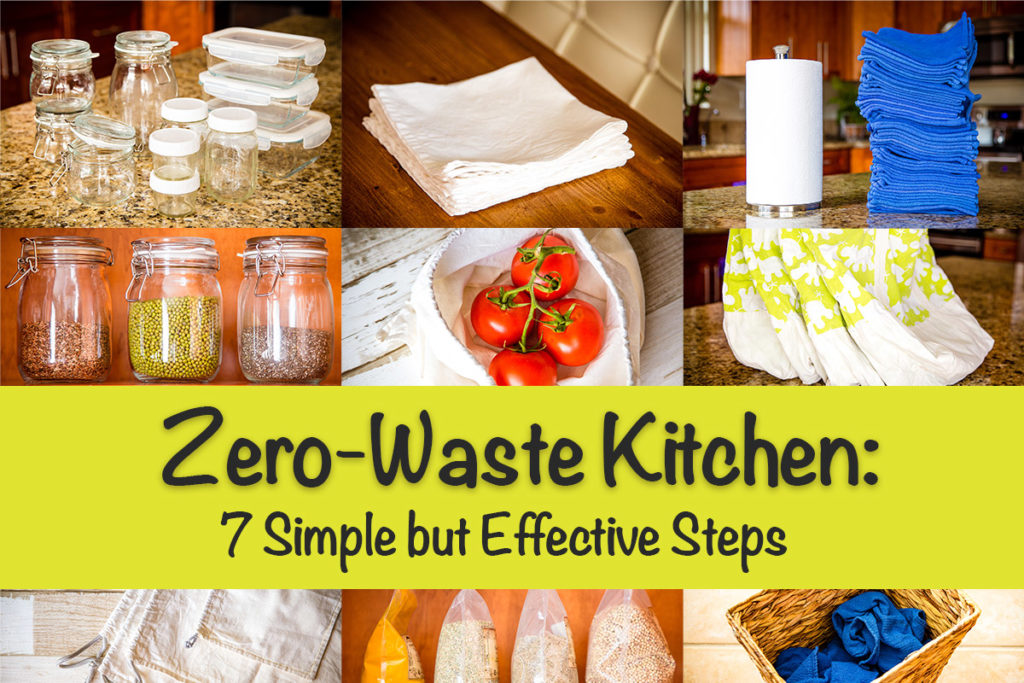
Love this post, I recently started transitioning into zero waste, and this post gave a lot of great information.
Thanks Tiff, I’m glad you found it helpful!
I try very hard to recycle or reuse everything. Even toilet rolls for seeding my plants or to wrap around my wrapping paper. But my family thinks I’m crazy. I even save food boxes to put their Xmas gifts in. When you tear off the paper, they think they got coffee or cereal etc.. It’s a hoot. Thank you for all the tips to save even more.
Haha, these are some very creative ways to reuse/recycle that you’ve come up with J.! Thanks for sharing, and glad that you found my tips helpful!
Can you use the cloth towels instead of paper towels to wrap/cover food when microwaving?